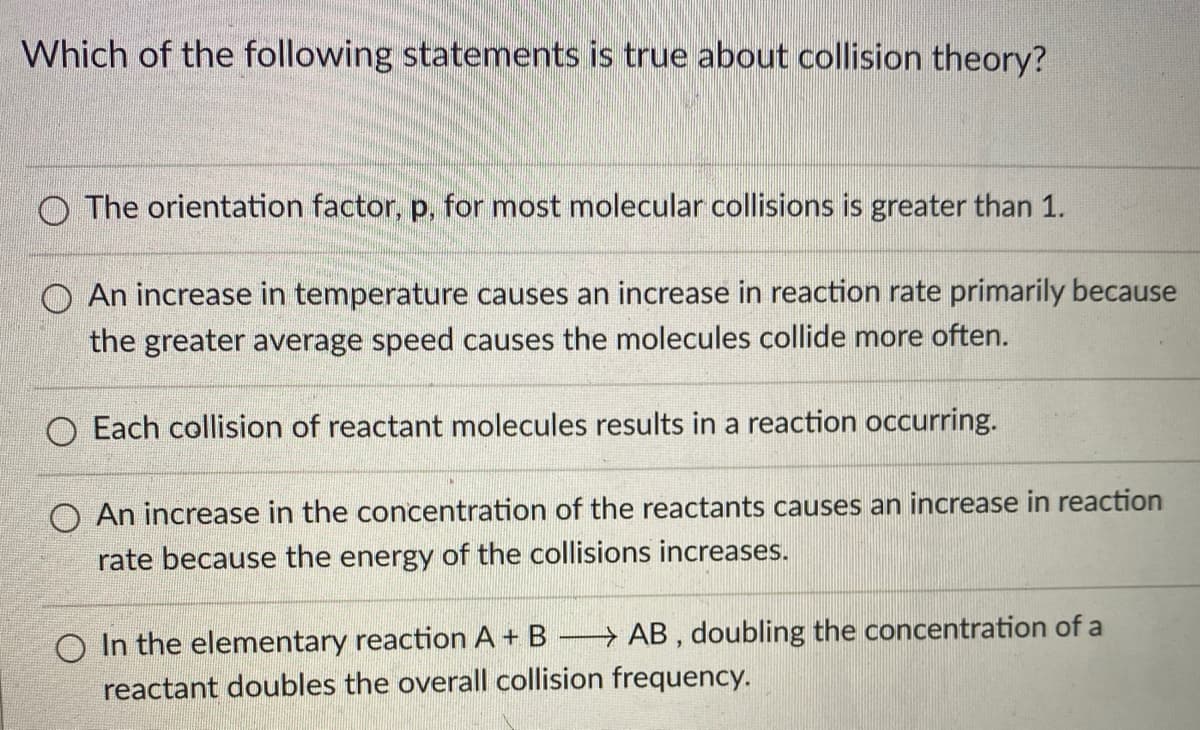A proposed mechanism is shown below: (CH3)3CB1(aq) → (CH3)3C*(aq) + Br (aq) slow (CH3);C*(aq) + H20(1) (CH3)3COH2 (aq) (CH3)3COH2*(aq) fast > (CH3)3COH2 (aq) H*(aq) + (CH3)3COH(aq) fast Experimentally, a plot of In[(CH3)3CBr] vs. time gives a straight line with a slope of -0.0215 s-1 Consider the following statements, and then select the best response belov i. The overall reaction is (CH3)3CB|(aq) + H2O(1) (CH3)3COH(aq) + Br (aq) ii. The only intermediate is (CH3)3COH2*(aq). iii. The mechanism is consistent with the experimental data. O Only statement (iii) is true. O None of the statements are true. O Only statement (ii) is true. Only two statements are true. O Only statement (i) is true.
Reactive Intermediates
In chemistry, reactive intermediates are termed as short-lived, highly reactive atoms with high energy. They rapidly transform into stable particles during a chemical reaction. In specific cases, by means of matrix isolation and at low-temperature reactive intermediates can be isolated.
Hydride Shift
A hydride shift is a rearrangement of a hydrogen atom in a carbocation that occurs to make the molecule more stable. In organic chemistry, rearrangement of the carbocation is very easily seen. This rearrangement can be because of the movement of a carbocation to attain stability in the compound. Such structural reorganization movement is called a shift within molecules. After the shifting of carbocation over the different carbon then they form structural isomers of the previous existing molecule.
Vinylic Carbocation
A carbocation where the positive charge is on the alkene carbon is known as the vinyl carbocation or vinyl cation. The empirical formula for vinyl cation is C2H3+. In the vinyl carbocation, the positive charge is on the carbon atom with the double bond therefore it is sp hybridized. It is known to be a part of various reactions, for example, electrophilic addition of alkynes and solvolysis as well. It plays the role of a reactive intermediate in these reactions.
Cycloheptatrienyl Cation
It is an aromatic carbocation having a general formula, [C7 H7]+. It is also known as the aromatic tropylium ion. Its name is derived from the molecule tropine, which is a seven membered carbon atom ring. Cycloheptatriene or tropylidene was first synthesized from tropine.
Stability of Vinyl Carbocation
Carbocations are positively charged carbon atoms. It is also known as a carbonium ion.
![A proposed mechanism is shown below:
(CH3)3CBr(aq) → (CH3)3C*(aq) + Br (aq)
slow
(CH3)3C*(aq) + H2O(1) → (CH3)3COH,*(aq)
fast
(CH3)3COH2*(aq) H*(aq) + (CH3)3COH(aq) fast
Experimentally, a plot of In[(CH3)3CBr] vs. time gives a straight line with a
slope of -0.0215 s-1
Consider the following statements, and then select the best response below.
i. The overall reaction is (CH3)3CBr(aq) + H2O(1) (CH3)3COH(aq) + Br
(aq)
ii. The only intermediate is (CH3)3COH2*(aq).
iii. The mechanism is consistent with the experimental data.
O Only statement (iii) is true.
O None of the statements are true.
O Only statement (ii) is true.
Only two statements are true.
O Only statement (i) is true.](/v2/_next/image?url=https%3A%2F%2Fcontent.bartleby.com%2Fqna-images%2Fquestion%2F04ad1141-e3fe-4631-bced-2c9f6272f5de%2F3d55ebe7-b61a-4d4a-b2a1-a88204e1faa0%2F4co6up9_processed.jpeg&w=3840&q=75)

Trending now
This is a popular solution!
Step by step
Solved in 3 steps


